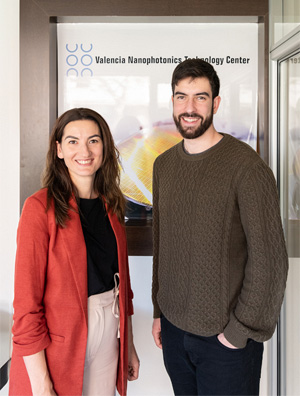Innovative metasurface
Designed by an NTC-UPV team, it favours the miniaturization of photonic device circuits.
[ 11/01/2024 ]
A team from the Nanophotonics Technology Centre (NTC) of the Universitat Politècnica de Valencia (UPV) has designed a new metasurface capable of acting as an optical insulator and manipulating the light that falls on it with great precision by enhancing the properties of magnetic materials. One of its advantages is that it would allow the development of very small optical insulators compared to current ones, thus contributing to the miniaturisation of circuits in photonic devices. The work has been published in the Advanced Optical Materials journal.
Metasurfaces are two-dimensional periodic structures formed by artificial atoms that simulate the behaviour of the atoms that make up matter but are designed to behave in a particular way depending on the application. They can be considered as artificial atoms.
"Although metasurfaces have already shown great potential in many applications, the realisation of certain transformations remains a mystery. Our work aims to go one step further to unveil it," says Ana Díaz Rubio, a researcher at the NTC of the Universitat Politècnica de Valencia. The NTC-UPV team also includes researchers from Aalto University (Espoo, Finland) and the University of Gothenburg (Gothenburg, Sweden).
Exploiting dark modes
In their study, they have managed to exploit a physical phenomenon based on so-called "dark modes". In optics, these modes, which some periodic structures can exhibit, are characterised by their almost infinite ability to confine light within a structure.
"We have used these modes to enhance the interaction between the light incident on the metasurface and the magnetic material with which it is designed. One of the most important features of this design is that it has a property required in many optical components known as non-reciprocity. This means that when light is shone on the device from one side, the same thing does not happen as when it is shone from the opposite side. Our design thus opens up a new way to maximise the interaction of light with magnetic materials in the optical regime (visible light) in a very small space," explains Luis Manuel Máñez-Espina, a predoctoral researcher at the UPV's Nanophotonics Technology Centre.
In addition, the metasurface designed by the team of Spanish, Swedish and Finnish researchers amplifies other magneto-optical effects resulting from the interaction of light with magnetic materials. These include the Faraday effect, which is characterised by the rotation of the electric field of light in different ways depending on the direction in which it propagates.
Reference
, , , , Extreme Nonreciprocity in Metasurfaces Based on Bound States in the Continuum. Adv. Optical Mater. 2023, 2301455. https://doi.org/10.1002/adom.202301455
Outstanding news
 The Diamond Army
The Diamond Army
Two students came up with the UPV initiative that has engaged more than 1,600 volunteers and shattered the false myth of the 'crystal generation'
 ARWU 2024
ARWU 2024
The Shanghai ranking reaffirms the UPV as the best polytechnic in Spain for yet another year
 Distinction of the Generalitat for Scientific Merit
Distinction of the Generalitat for Scientific Merit
Guanter has been distinguished in recognition of his research excellence in the development of satellite methods for environmental applications
 The new statutes come into force
The new statutes come into force
The Universitat Politècnica de València is the first university in Spain with statutes adapted to the new LOSU
 NanoNIR project against breast cancer
NanoNIR project against breast cancer
UPV Researcher Carla Arnau del Valle receives an EU Marie Curie grant to develop biosensors for the early detection of this cancer
 Large artificial intelligence language models, increasingly unreliable
Large artificial intelligence language models, increasingly unreliable
According to a study by the Universitat Politècnica de València, ValgrAI and the University of Cambridge, published in the journal Nature





